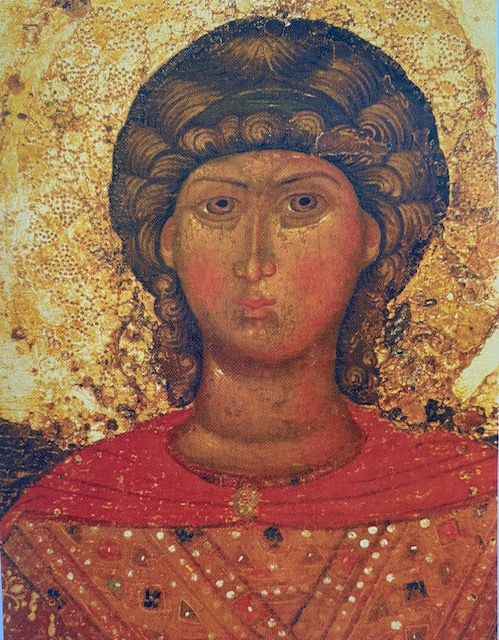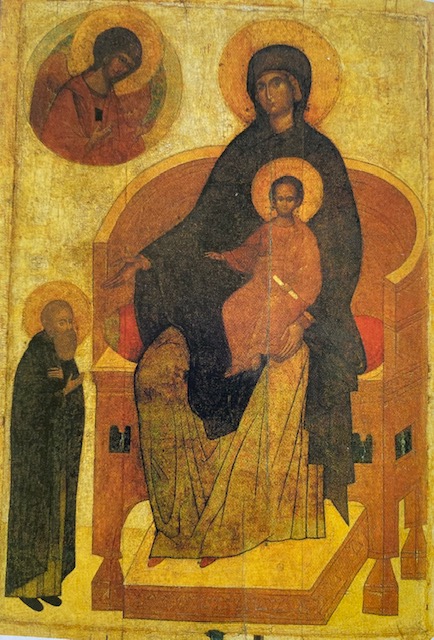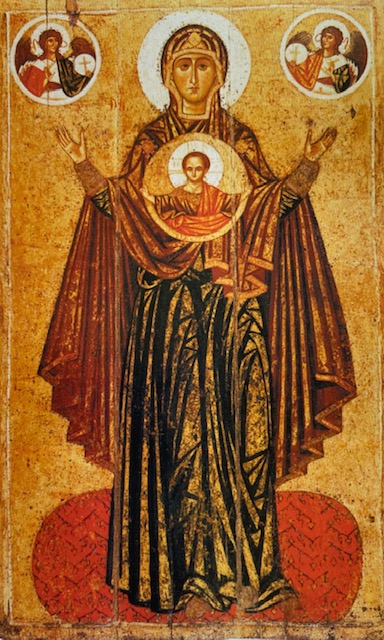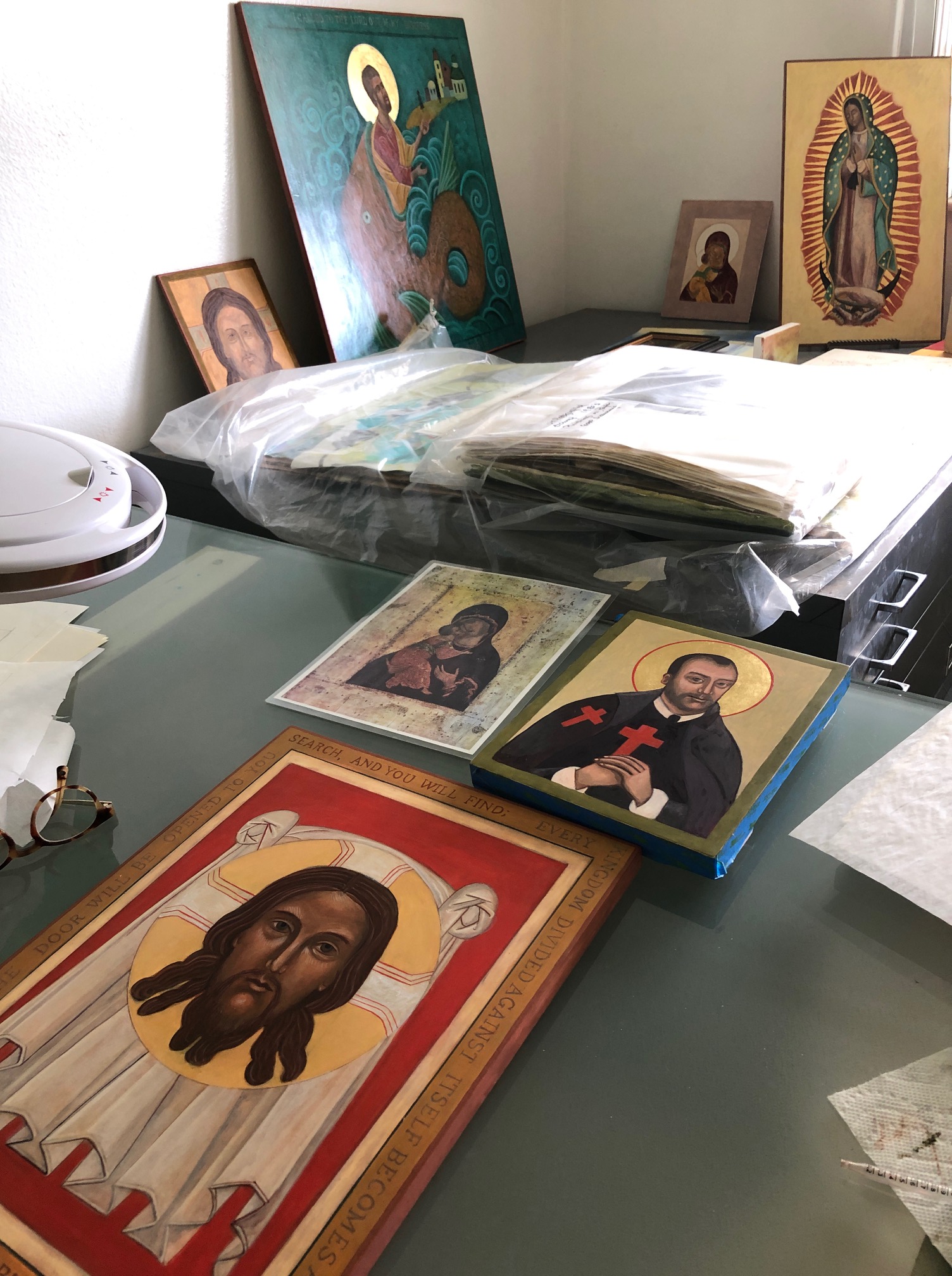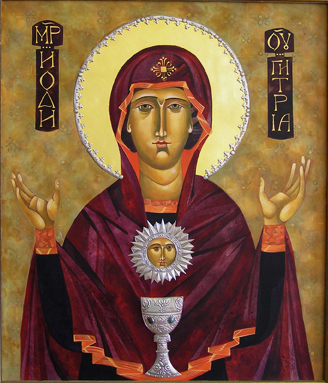The following article was submitted by educator and iconographer, Jeannie Furlong. Thank you Jeannie, I’m sure these book reviews will be very helpful, and help to spread the joy of icon writing around the world!
Icon Books, from Jeannie Furlong:
My interest in Icons seems to have been with me for as long as I can remember. It was their stillness and austere beauty that caught my eye, initially! My artist background couldn’t keep me from analyzing what I was seeing. Each new Icon fed my embers of interest and before long a small fire had ignited. I needed to know more!
I purchased my first Icon reproduction, Holy Trinity by St. Andrei Rublev. I then found two intriguing books, Icons andSpiritual Geometry, to read. I also purchased a set of egg tempera pigments to use in the future. Gradually, I realized I was being guided into a steady path centered on learning about and creating icons.
Next, what I really needed was a teacher with the patience of Job. Where? in the midst of a raging Covid pandemic would I find one? Many, many prayers (plus Google) brought me the answer, when a ‘search’ popped up Christine Hales Iconographer! And, she was offering a Virtual Icon class. My learning curve has been straight up; an amazing beginning, and I have learned an unbelievable amount about Icons under her instruction. Now, I am pleased to accept her invitation to share with you a few of the books I found useful on my journey, especially if you are a neophyte, like myself!
I’ve listed sources alphabetically by author. Each has unique information! Enjoy!
Praying with Icons by Jim Forest. Orbis Books, 1997. (Available from Amazon.com on Kindle). The author begins with retelling a personal journey early on with Icons. The interesting aspect, surprisingly enough, is that he is NOT an Iconographer, but his story is very ‘hands-on’ sharing his experiences with Icons. In addition to Icon information and interviews, the author delves into Learning to Pray. He surprises the reader in his section on prayers, with his inclusion of two specific prayers for the Iconographer which are The Rules for the Icon Painter and An Iconographer’s Prayer.
Eyes of Fire How Icons Saved My Life by Christine Hales. Christine Hales 2018. (Available from Amazon.com) The author uses a conversational voice taking the reader on a journey beginning with life discoveries that ‘saved her life’ and continues to chat along the way discussing the values found in many periods of art. Throughout the pages are beautiful color illustrations that spur the reader on. Building this background of information she creates a deeper understanding of Icons that as an art form wields spirituality by virtue of being an art form. Christine’s book is “about” writing Icons explaining foundational processes used for creating icons. It confirms that Icons are a window the artist speaks through, “With this method of art practice, the next step is to combine that with prayer, and in doing so, the Holy Spirit will lift up the space between hand, brush and board, and the reflection of Grace will manifest in your Icon, to be read by any receptive heart.”
Drawing Closer to CHRIST A Self-Guided Icon Retreat by Joseph Malham. Ave Maria Press. 2017. (Available from Amazon.com). The author takes the reader on a very defined study of Icons that includes study and painting. A self-directed “guide into the act of iconography, which is an act of prayer. It has been divided into seven chapters, which not only measure the days it will take to create your icon but also an approximation of the days in which God created everything from nothing.” The study and painting focus on the Icon Pantocrator. These seven chapters use a biblical passage to introduce the Day with the authors’ comments, proceeds to Theological Reflections and continues with Painting the Icon. In the Guidelines, the author encourages the participant, “Remember this is a retreat and not a work project with a deadline. Your seven-day retreat will be a fluid motion of prayer centered on the rhythm you set.”
Sacred Doorways A Beginner’s Guide To Icons by Linette Martin. Paraclete Press, 2002. (Available from Thriftbooks.com). As mentioned in the Preface by Dr Nicholas Gendle, Editor, this book is practical and by no means technical but purposely authored to appeal to the beginner seeking information about Icons. It is written in a very ‘conversational’ voice that carries the reader smoothly from chapter to chapter while delivering a great amount of information carefully crafted without overwhelming the reader. This wealth of information does whet the readers’ appetite to want more information. It could certainly fit the bill as a resource for a study group seeking to know about Icons or an individual preparing to take an Icon class. Chapter 8, God, Angels and People, extends a sense of familiarity about a few icons and terminology used in Christian settings sometimes ‘taken for granted’. This chapter expands the meaning of familiar terminology and explains how it relates within the church.
Icon Painting Technique: A Meditative Guide to Egg Tempera Painting by Mary Jane Miller. Mary Jane Miller, 2013. (Available from Amazon.com-Kindle) The author prepares the reader in the Introduction: “The book is about the subtle relationship between the icon painting and how it reflects and enriches ones spiritual life”.
Silence, plays a major role in the process of creating an icon as an “extraordinary kind of prayer” from beginning to end. “Icons are not portraits; they are a windows on a world that call us to be still, to look and reflect, to be at peace with ourselves, and to rest in a place of thankfulness with God.” The author substitutes the terminology of ‘painting’ for ‘writing’ in her discussion and explains why in the History Chapter. In the Chapter Technique & Materials, she author provides an extensive discussion about her special philosophy while painting with egg tempera. She also provides various ratios she uses in her painting. Painting the Icon is broken into 12 Steps. Each simplifies the painting of each icon to enhance listening to God.
Techniques of Traditional Icon Painting by Giles Weissman, Search Press, 2012. (Available on Amazon.com). A very sturdy paperback that focuses in great detail on the “processes” of writing Icons. It also contains beautiful full color illustrations including a ‘bird’s eye glimpse’ of the detailing for a reference for painting. Chapter 5 – Byzantine Drawing points out “the elements of the composition are positioned for balanced and harmony”. The author continues using detailed step by step information clarified by the narrative while beautiful pictures identify what your work will look like at each phase. Chapter 8 – Inscriptions explains the importance of an inscription, how to paint it, and includes many inscriptions with an interpretation and origin for them.
Article contributed by Jeannie Furlong:
Jeannie Furlong, Ed.D. Episcopalian, Wife, Mother, Grandmother of 11, Texan, Business Owner, Former Educator, Professor and future Iconographer! Conversation welcomed at jeanniejeanniejeannie@yahoo.com
Useful Links For Iconographers:
Greek Iconographer, Antonis with instruction on the Cretan style of iconography. It is a simple study which can help with dry brush technique:
This is an article by Koo Schadler on the dry brush technique.
Online Icon Painting Classes with Christine Hales
That’s all for this month!
God Bless,
Christine Simoneau Hales







